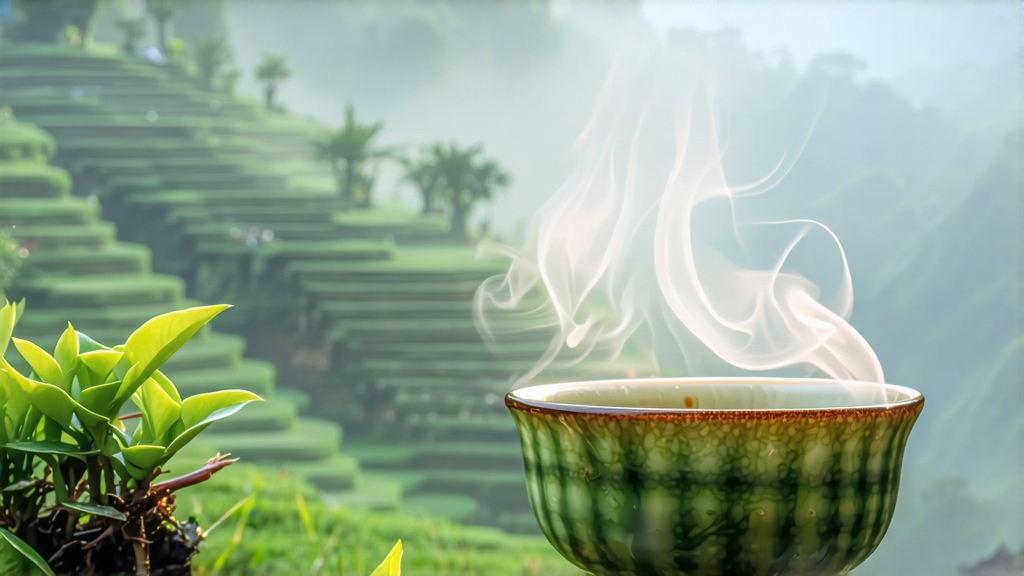
Nestled between the Tropic of Cancer and the 23rd parallel, the Alishan mountain range rises like a spine of emerald vertebrae through south-central Taiwan. Between 1,000 and 1,400 metres above sea level, the daily interplay of cloud, sun and chill transforms tea bushes into aromatic alchemists, producing what Taiwanese farmers simply call “Alishan High-Mountain Oolong.” To international drinkers it is one name, yet within that name lies a mosaic of micro-gardens, cultivars and craft lineages that have evolved since the late nineteenth century. This article invites you to wander those cloud-veiled terraces, to witness the leaf’s journey from dawn mist to glowing amber liquor, and to learn how to coax its orchid fragrance into your own teapot.
-
Historical Footprints in Cloud Soil
Tea migration to Taiwan followed the same maritime currents that carried Min-nan dialects across the strait. In 1855, a Fujianese planter named Lin Feng-chi ferried Qingxin oolong cuttings from the Wuyi cliffs to Taipei county; half a century later, Japanese agronomists expanded mountain plantations to supply imperial demand. After 1949, Kuomintang veterans transplanted both skill and nostalgia, pushing the planting frontier southward into Chiayi’s Alishan massif. The cool, fog-laden habitat slowed leaf growth, concentrating amino acids and volatiles, and by the 1980s Alishan oolong had eclipsed lower-elevation teas at island-wide competitions. Today, every spring and winter harvest is still preceded by a quiet ritual: farmers burn incense to the Earth God, asking for “three days of sun, two days of fog,” the meteorological mantra that gives Alishan its signature milky jin-xiang (golden fragrance). -
Cultivar and Terroir: The Genetic Score
The dominant cultivar is Qingxin (Chin-shin) oolong, a shy-bearing bush whose small, leathery leaves are tailor-made for high altitudes. At 1,200 m, nighttime temperatures can drop to 12 °C even in May; the plant responds by thickening cell walls, creating the precursor compounds that later translate into lilac and custard apple notes. Ultraviolet intensity increases 8 % for every 1,000 m ascent, prompting greater production of catechins and aromatic terpenes, yet the same altitude reduces leaf bitterness by slowing the conversion of theanine to polyphenols. The result is a kinetic balance: bright floral lift riding on a satin-sweet body, anchored by a mineral tail that Taiwanese cuppers liken to “stone fruit kissed by spring water.” -
Crafting the Leaf: A Choreography of Wither, Shock and Breath
Harvest begins at 7 a.m. when dew still pearls the leaf tips. Two leaves and a bud are snapped with the thumbnail, never twisted, to keep cell rupture minimal. The loaded bamboo baskets are rushed to the on-mountain factory where the first act—sun withering—lasts only twenty minutes; high-elevation UV is so intense that over-exposure would bake the leaf. Next comes indoor withering on slatted bamboo trays, where electric fans simulate the mountain breeze while the leaf loses 10 % moisture. The critical “shaking” phase follows: trays are stacked and vibrated every hour, bruising epidermal cells just enough to trigger oxidation enzymes. Tea makers listen for a rustle that sounds like “rain on banana leaves,” an auditory cue that oxidation has reached 25 %. At this point the leaf is passed through heated tumblers (sha-qing) that halt oxidation at 30 %, preserving the jade-green centre while rimming the leaf edges with russet. Rolling is done in two stages: first a cloth-wrapped cannonball spin that twists leaves into hemispheres, then a lighter kneading that encourages surface oils to emerge. The final low-temperature bake (80 °C for six hours) is more drying than roasting, locking in the alpine bouquet. Only 18 kg of finished tea emerge from every 100 kg of fresh leaf, a ratio even lower than Darjeeling first flush. -
Flavour Cartography: Tasting the Mountain
Professional cuppers evaluate Alishan oolong through five flashing infusions, each 45 seconds apart. First steep: liquor the colour of chardonnay releases a nose of white gardenia and fresh cream. Second steep: a hint of alpine sage appears,